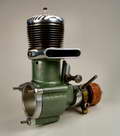|
|
Meanwhile "back at the ranch" in merrie olde England, Barry and Alan Holmes, Jr. whose company, Dunham Engineering, 12, Lawns Ave., Orrell, Wigan. WN5 8UQ, was manufacturing a Mechanair 6.5 old timer replica, their own Valkyrie 5.33 diesel, announced their reproduction Orwick line. The line included the .73, .64, .32 and the .29 but did not include the .23...all of this about the same time as the K&M Orwicks came on the market.
Bert Streigler, Streigler's R/C Supply, 5831 McKnight, Houston, TX, 77035, was selected as the US importer and distributor for this handsome replica line. Bert had lent his original Orwick 64, #65453 to the Holmes and had later found and sent them a .32 which they copied. George Aldrich had sent them an original Orwick 29 for their purposes.
A careful examination of both lines of the Orwick replicas indicates that the Dunhams were about 95% faithful and the K&Ms almost 100%. The cases for the Dunham engines were diecast in a two piece steel die, not sandcast. BA screws were utilized throughout except for the prop nut with standard American thread. The base for attaching the exhaust was slightly different, the prop washer much smaller as was the nut, the stack casting was slightly different, the prop drive/ignition cam was secured by a split collet instead of the square drive, and three types of needles were utilized. Glossy, smooth, green paint was used, and all had the Japanese NGK spark plugs. All in all Bert Streigler estimates that during the 1984-86 selling seasons about 150 73's, some 700 64s, and around 200 32s and 29s were sold in the USA. The prices were $140 to $190, and the larger engines came in an attractive carton with coil, condenser, and a set of optional beam mounts, as well as a copy of the original Orwick parts and running instructions. A close fitting brown box came with the smaller engines along with the instruction and beam mounts. These were very attractive engines, polished and new and "crisp" looking, but early on the fellows who used them for actual flying discovered that the crankshafts weren't hardened properly if at all. The Holmes, to their credit stood behind the problems and corrected them for those who asked.
In commenting on the Dunham engines through an article in the new British Magazine, "Model Engine World", March, 1997, Bert Streigler noted additional interesting facts about the company and its products. The Orwick 29 diesel (Henry never made one) was also produced in small numbers, based on the 32 case, and were strong runners. Several 64 and 29 engines were modified for Super Tigre throttles with special muffler. A 29 R/C version was produced on a 32 crankcase as the cast-in-exhaust was better for mounting a muffler. Only a single magneto version of the 64 was set up, and it ran well with it on the backplate, but complexity and cost prohibited its manufacturing.
 Bert goes on to note that sales of the engines were good, when one considered a US made replica came out about the same time as Dunham's. (K&M of course) The Dunham product was cheaper and product quality as good. (Not quite, Bert). So why did Dunham stop production? I think it was a simple matter of economics more than anything else. Also there was a lot of disappointment that the engines sold so poorly in England...we should all reflect on the amount of work that it takes to produce a product like a model airplane engine....imagine spreading the cost of tooling, dies, research, printing and distribution over the small number of engines that can be reasonably sold...at a profit? It has to be more a labor of love than a real business.
Bert goes on to note that sales of the engines were good, when one considered a US made replica came out about the same time as Dunham's. (K&M of course) The Dunham product was cheaper and product quality as good. (Not quite, Bert). So why did Dunham stop production? I think it was a simple matter of economics more than anything else. Also there was a lot of disappointment that the engines sold so poorly in England...we should all reflect on the amount of work that it takes to produce a product like a model airplane engine....imagine spreading the cost of tooling, dies, research, printing and distribution over the small number of engines that can be reasonably sold...at a profit? It has to be more a labor of love than a real business.
So how does the original compare with the replicas recently made? Henry's Orwicks, quality and looks wise stands between them, but his "hand fitted" pistons and cylinders are still the best. Collectors still prefer the original gems but the replicas are all sold and are in collections. Prices reflect the scarcity of all the Orwick engines, original and reproduction. High!
 Back to Model Engine News Home
Back to Model Engine News Home
Back to Janson Index Please submit all questions and comments to [email protected]